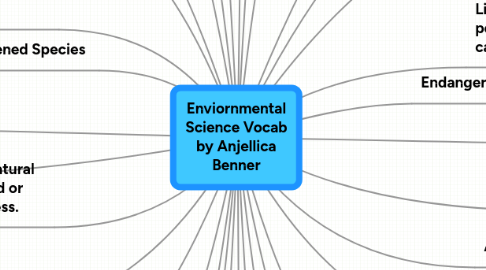Enviornmental Science Vocab by Anjellica Benner
by Anjellica Benner


1. Biomes
1.1. Rainforest
1.2. Temperate deciduoius forest
1.3. Coniferus forest
1.4. Desert
1.5. Tundra
1.6. Freshwater
1.7. Marine
1.8. Grassland
2. Biotic Factors
2.1. Humans
2.2. Animals
2.3. Plants
3. Biodiversity: The variety of organisms in a specific geographic area.
3.1. Genetic Biodiversity: The variety of genes within a breeding population.
3.2. Species Biodiversity: The number of different species found in an environment.
3.3. Ecosystem Biodiversity: Climate change, land use changes, resource demands, population growth and other human-induced changes.
4. Threatened Species
4.1. Lark
4.2. Aardvark
4.3. Elephant
5. Ecological Succession: A process in which the communities of an ecosystem change over time.
5.1. Primary Succession: The gradual growth of organisms in an area that was previously bare.
5.2. Secondary Succession: The series of community changes which take place on a previously colonized, but disturbed or damaged habitat.
6. Climax Community: A stable community of a diverse number of species.
7. Carrying Capacity: The number of individuals of a species that an ecosystem can support.
8. Population Growth Rate: The rate at which the number of an organism increases in a territory.
9. J-Curve: Shows a steady population, then shoots up, representing a fast increase in population.
10. Aquifer: A body of saturated rock through which water can easily move.
11. Desalination: The removal of salt from water.
12. Water Purification: The process of removing undesirable chemicals, materials, and biological contaminants from raw water.
13. Wetlands: An area of land whose soil is saturated with moisture either permanently or seasonally.
14. Urbanization: The physical growth of urban areas as a result of global change.
15. Renewable Resources: A natural resource that can be reused or replaced by a natural process.
15.1. Trees
15.2. Oxygen
15.3. Animals
16. Non-Renewable Resources: A natural resource that cannot be reproduced or reused.
16.1. Plastics
16.2. Minerals
16.3. Fossil Fuels
17. Levels of Organization
17.1. Organism
17.2. Population
17.3. Community
17.4. Ecosystem
17.5. Biome
18. Trophic Levels
18.1. Decomposers
18.2. Tertiary Consumers
18.3. Secondary Consumers
18.4. Primary Consumers
18.5. Producers
19. Abiotic Factors
19.1. Water
19.2. Air
19.3. Clouds
20. Hot spots: Spots that are severly threatened by humans.
21. Endangered Species
21.1. Bald eagle
21.2. Lynx
21.3. Puma
22. Indicator Species: Any biological species that defines a trait or characteristic of the environment.
23. Pioneer Species: Species which colonize previously uncolonized land, usually leading to ecological succession.
24. Limiting Factors: Factors that prevent a population from reaching carrying capacity.
25. Population Growth: An increase in the number of people who inhabit a territory.
26. Expontential Growth: Occurs when some quantity regularly increases by a fixed percentage.
27. S-Curve: Its exponential growth has a steady start to begin with, then quickly increases, and then finally levels off.
28. Water Pollution
28.1. Point Source
28.1.1. Municipal sewage discharge
28.1.2. Heavy metals
28.2. Non-point Source
28.2.1. Oil runoff
28.2.2. Tiny gas leaks
28.3. Organic
28.3.1. Hydrocarbons
28.3.2. Pesticides
28.4. Inorganic
28.4.1. Lead
28.4.2. Copper
